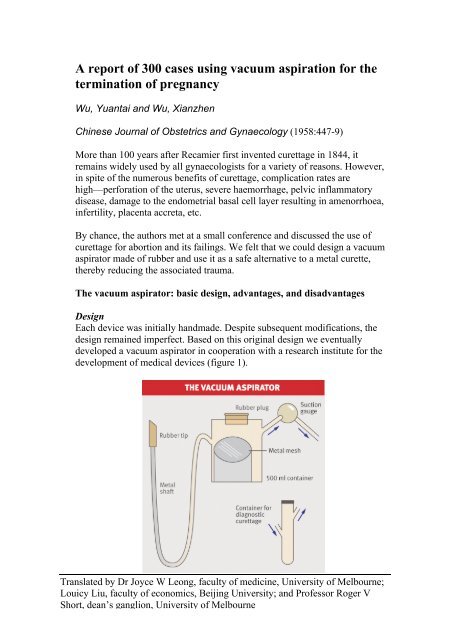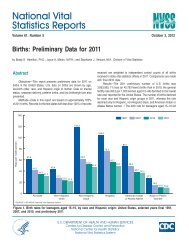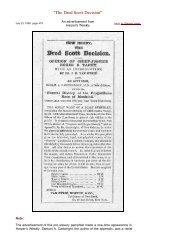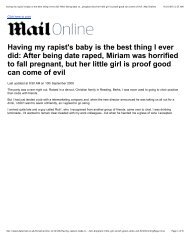A report of 300 cases using vacuum aspiration for the termination of ...
A report of 300 cases using vacuum aspiration for the termination of ...
A report of 300 cases using vacuum aspiration for the termination of ...
You also want an ePaper? Increase the reach of your titles
YUMPU automatically turns print PDFs into web optimized ePapers that Google loves.
A <strong>report</strong> <strong>of</strong> <strong>300</strong> <strong>cases</strong> <strong>using</strong> <strong>vacuum</strong> <strong>aspiration</strong> <strong>for</strong> <strong>the</strong><strong>termination</strong> <strong>of</strong> pregnancyWu, Yuantai and Wu, XianzhenChinese Journal <strong>of</strong> Obstetrics and Gynaecology (1958:447-9)More than 100 years after Recamier first invented curettage in 1844, itremains widely used by all gynaecologists <strong>for</strong> a variety <strong>of</strong> reasons. However,in spite <strong>of</strong> <strong>the</strong> numerous benefits <strong>of</strong> curettage, complication rates arehigh—per<strong>for</strong>ation <strong>of</strong> <strong>the</strong> uterus, severe haemorrhage, pelvic inflammatorydisease, damage to <strong>the</strong> endometrial basal cell layer resulting in amenorrhoea,infertility, placenta accreta, etc.By chance, <strong>the</strong> authors met at a small conference and discussed <strong>the</strong> use <strong>of</strong>curettage <strong>for</strong> abortion and its failings. We felt that we could design a <strong>vacuum</strong>aspirator made <strong>of</strong> rubber and use it as a safe alternative to a metal curette,<strong>the</strong>reby reducing <strong>the</strong> associated trauma.The <strong>vacuum</strong> aspirator: basic design, advantages, and disadvantagesDesignEach device was initially handmade. Despite subsequent modifications, <strong>the</strong>design remained imperfect. Based on this original design we eventuallydeveloped a <strong>vacuum</strong> aspirator in cooperation with a research institute <strong>for</strong> <strong>the</strong>development <strong>of</strong> medical devices (figure 1).Translated by Dr Joyce W Leong, faculty <strong>of</strong> medicine, University <strong>of</strong> Melbourne;Louicy Liu, faculty <strong>of</strong> economics, Beijing University; and Pr<strong>of</strong>essor Roger VShort, dean’s ganglion, University <strong>of</strong> Melbourne 1
1. The rubber tip is <strong>the</strong> most important part <strong>of</strong> <strong>the</strong> whole device. 150successful abortions were per<strong>for</strong>med with a metal shaft <strong>of</strong> 7 mm internaldiameter, <strong>using</strong> a 4 cm rubber ca<strong>the</strong>ter tip <strong>of</strong> 5mm inner diameter. . . Theangle <strong>of</strong> <strong>the</strong> tip was most important in determining <strong>the</strong> degree <strong>of</strong> suction.We found that 40 degrees was best. The bigger <strong>the</strong> angle, <strong>the</strong> greater <strong>the</strong>probability <strong>of</strong> haemorrhage.2. The metal shaft was necessary to control <strong>the</strong> movement <strong>of</strong> <strong>the</strong> ca<strong>the</strong>ter in<strong>the</strong> uterus. . . we found that <strong>the</strong> 7 mm internal diameter shaft was best. Theonly problem was that <strong>the</strong> cervix has to be dilated up to 9mm, which maymake <strong>the</strong> patient uncom<strong>for</strong>table.3. The container. A 500 ml sterile container with a metal screen was used sothat <strong>the</strong> blood collected at <strong>the</strong> bottom, whilst <strong>the</strong> products <strong>of</strong> conceptionremained on <strong>the</strong> mesh. These can be identified by an experienced operator.4. The suction. The best <strong>for</strong>m <strong>of</strong> <strong>vacuum</strong> is produced hydraulically or by anelectric pump. The power <strong>of</strong> <strong>the</strong> suction is a key factor in <strong>the</strong> extractionoperation. The suction should be around 0.25 horsepower.Our experience1. One abortion was per<strong>for</strong>med by hysterotomy at <strong>the</strong> third month <strong>of</strong>pregnancy. We used a metal aspirator . . . to extract <strong>the</strong> conceptus underdirect vision and this proved to be successful.2. One abortion was per<strong>for</strong>med on a two month pregnancy <strong>using</strong> a Novakcurette with suction. However, <strong>the</strong> 2 mm internal diameter tube becameblocked, so <strong>the</strong> abortion had to be completed by curettage.3. 50 abortions <strong>of</strong> 40-70 day pregnancies were per<strong>for</strong>med <strong>using</strong> a rubberca<strong>the</strong>ter <strong>of</strong> 8 mm internal diameter . . . The angle <strong>of</strong> <strong>the</strong> tip was 40 degreesand <strong>the</strong> cervix was dilated to more than 12 mm . . . For <strong>the</strong> early stages <strong>of</strong>pregnancy, <strong>the</strong> extraction was successful <strong>the</strong> first time but at later stages <strong>of</strong>gestation, it had to be repeated because <strong>the</strong> placenta obstructed <strong>the</strong> ca<strong>the</strong>ter. . . Reorientation <strong>of</strong> <strong>the</strong> ca<strong>the</strong>ter is necessary if <strong>the</strong>re is only decidualtissue in <strong>the</strong> container. Curettage was used at <strong>the</strong> end <strong>of</strong> <strong>the</strong> procedure as aconfirmatory check. 60% <strong>of</strong> <strong>the</strong>se operations were successful, while <strong>the</strong>rewere remnants <strong>of</strong> products <strong>of</strong> conception in <strong>the</strong> remaining 40%. Probablecauses <strong>of</strong> failure are likely to be operator-dependent and lack <strong>of</strong> asufficiently flexible rubber ca<strong>the</strong>ter. During <strong>the</strong> procedure we observedminimal haemorrhage . . . in general <strong>the</strong> quantity <strong>of</strong> blood loss wasTranslated by Dr Joyce W Leong, faculty <strong>of</strong> medicine, University <strong>of</strong> Melbourne;Louicy Liu, faculty <strong>of</strong> economics, Beijing University; and Pr<strong>of</strong>essor Roger VShort, dean’s ganglion, University <strong>of</strong> Melbourne 2
observed to be 20-30 ml . . . including amniotic fluid. Subsequent bleedingafter <strong>the</strong> procedure was minimal and less than that caused by curettage . . .4. 50 abortions <strong>of</strong> 40-85 day pregnancies were per<strong>for</strong>med with a metal shaft<strong>of</strong> 7 mm inner diameter and a rubber tip <strong>of</strong> 5 mm inner diameter. Theangle <strong>of</strong> <strong>the</strong> bevel was <strong>the</strong> same as <strong>the</strong> above. The cervix was dilated to 9mm . . . and all <strong>the</strong> operations were completed in 2-3 minutes with optimalresults. The amount <strong>of</strong> bleeding, including amniotic fluid, was an average<strong>of</strong> 50 ml. A final check by curettage was per<strong>for</strong>med be<strong>for</strong>e <strong>the</strong> end <strong>of</strong> <strong>the</strong>procedure . . . overall <strong>the</strong>re were minimal products <strong>of</strong> conception foundduring <strong>the</strong> check. There was a very high success rate with this method.5. 50 abortions were per<strong>for</strong>med with metal shafts <strong>of</strong> various inner diameters .. . however, <strong>the</strong> angle <strong>of</strong> <strong>the</strong> bevel remained <strong>the</strong> same. The cervix wasdilated as wide as needed, but <strong>the</strong> results were less promising. The successrate was 20%, while large pieces <strong>of</strong> <strong>the</strong> conceptus remained in utero in <strong>the</strong>o<strong>the</strong>r 80%. In some <strong>cases</strong>, excessive haemorrhage <strong>of</strong> up to 500 mloccurred . . .6. 18 abortions were per<strong>for</strong>med with a metal shaft <strong>of</strong> 2 mm inner diameter . .. and a rubber tip. The bevel remained <strong>the</strong> same and hydraulic suctionpower was used. The cervix was dilated to 6.5 mm, and <strong>the</strong> procedurelasted <strong>for</strong> . . . an average <strong>of</strong> 25 minutes. The quantity <strong>of</strong> bleeding averaged<strong>of</strong> 40 ml. A final check by curettage was per<strong>for</strong>med at <strong>the</strong> end <strong>of</strong> everyprocedure . . .7. 25 procedures were per<strong>for</strong>med on incomplete abortions. Rubber cannulas<strong>of</strong> 8 mm inner diameter were used with no cervical dilatation necessary . .. <strong>the</strong> results were generally positive. Only <strong>the</strong> necrotic placenta wasextracted, so <strong>the</strong> uterine mucosa remained intact, which reduced <strong>the</strong>possibility <strong>of</strong> pelvic inflammatory disease.8. 5 operations were per<strong>for</strong>med <strong>for</strong> diagnostic curettage. Metal cannulas <strong>of</strong> 2mm inner diameter were used with rubber tips, with <strong>the</strong> same angle <strong>of</strong> <strong>the</strong>bevel as above. Suction with 0.125 horsepower was used and <strong>the</strong>procedure lasted <strong>for</strong> 1-2 minutes with a very high success rate.Brief summary1. Pelvic inflammatory disease occurs after curettage <strong>for</strong> spontaneous orincomplete abortion, however, <strong>vacuum</strong> extraction rarely results in thiscomplication. It may still be too early to prove this conclusively withoutcarrying out fur<strong>the</strong>r experiments . . .Translated by Dr Joyce W Leong, faculty <strong>of</strong> medicine, University <strong>of</strong> Melbourne;Louicy Liu, faculty <strong>of</strong> economics, Beijing University; and Pr<strong>of</strong>essor Roger VShort, dean’s ganglion, University <strong>of</strong> Melbourne 3
2. For diagnostic curettage, <strong>the</strong> patient has to be in hospital <strong>for</strong> 1-2 days, and<strong>the</strong> procedure has to be per<strong>for</strong>med in an operating <strong>the</strong>atre. Using <strong>vacuum</strong>extraction <strong>for</strong> <strong>the</strong> same purpose, <strong>the</strong> procedure can easily be carried out ina mobile clinic without any medication needed (<strong>the</strong> cervix is only slightlydilated), in a few minutes.3. Hydatidi<strong>for</strong>m moles were not observed in any <strong>of</strong> our patients . . .4. With regards to <strong>using</strong> <strong>vacuum</strong> <strong>aspiration</strong> <strong>for</strong> <strong>the</strong> purposes <strong>of</strong> inducedabortion:a. Ca<strong>the</strong>ters with inner diameters larger than 7 mm are satisfactory<strong>for</strong> pregnancies <strong>of</strong> less than 70 days.b. Ca<strong>the</strong>ters <strong>of</strong> 2 mm inner diameter are satisfactory <strong>for</strong> pregnanciesless than 50 days . . .Initial experience and analysis <strong>of</strong> <strong>vacuum</strong> <strong>aspiration</strong>1. We initially postulated that <strong>the</strong> potential complications caused by <strong>vacuum</strong><strong>aspiration</strong> would be uterine inversion, severe haemorrhage, desquamatedendometrium, etc. Once we attempted to induce uterine inversion afterhysterectomy and found that it would require an extremely high suction.Of course we acknowledge that <strong>the</strong>re must be a difference between anexcised uterus and one containing an embryo. During <strong>the</strong> first operationwhere <strong>the</strong> abortion was per<strong>for</strong>med by hysterotomy, we observed that <strong>the</strong>conceptus and decidua were easily extracted and desquamated, while <strong>the</strong>endometrium was not. And even after <strong>for</strong>cible extraction it was difficult todesquamate <strong>the</strong> endometrium. In <strong>the</strong> case <strong>of</strong> a hysterectomy per<strong>for</strong>med onone patient with endometrial hyperplasia and dysfunctional uterinebleeding, we subsequently used <strong>the</strong> <strong>vacuum</strong> aspirator to remove <strong>the</strong>hyperplastic endometrium. We observed that <strong>the</strong> pathologicalendometrium was easily sucked out whereas <strong>the</strong> normal endometrium wasnot. Severe haemorrhage only occurred in 14 <strong>of</strong> <strong>the</strong> <strong>300</strong> experimentalprocedures per<strong>for</strong>med, but after some modifications (as describedpreviously) this complication no longer occurred.2. There were 14 patients who experienced bleeding <strong>of</strong> over 150mls, withone patient losing 50 0ml <strong>of</strong> blood (3 month pregnancy). However, <strong>for</strong> all<strong>300</strong> <strong>cases</strong> <strong>the</strong> average amount <strong>of</strong> bleeding was 150-<strong>300</strong>ml. All <strong>the</strong> 14 <strong>cases</strong><strong>of</strong> severe haemorrhage occurred in <strong>the</strong> first two weeks <strong>of</strong> our trial, when<strong>the</strong> angles <strong>of</strong> <strong>the</strong> bevels on <strong>the</strong> rubber tips exceeded 40• or even 60•,combined with insufficient suction power (0.125 horsepower).Subsequently <strong>the</strong> angle was reduced to 40•, coupled with a more powerfulTranslated by Dr Joyce W Leong, faculty <strong>of</strong> medicine, University <strong>of</strong> Melbourne;Louicy Liu, faculty <strong>of</strong> economics, Beijing University; and Pr<strong>of</strong>essor Roger VShort, dean’s ganglion, University <strong>of</strong> Melbourne 4
suction <strong>of</strong> 0.25 horsepower. The haemorrhagic complications were thuseliminated. We concluded that <strong>the</strong> cause <strong>of</strong> severe bleeding wasincomplete placental separation due to insufficient suction.3. Several suggestions to guarantee <strong>the</strong> success <strong>of</strong> <strong>the</strong> procedure:i. There should be space to allow air flow into <strong>the</strong> uterus during <strong>the</strong>procedure. We first tried fluting <strong>the</strong> rubber cannula, <strong>the</strong>n <strong>using</strong> aflat metal cannula, but <strong>the</strong> results from both were less promisingthan expected. We finally dilated <strong>the</strong> cervix 1.5-2mm wider than<strong>the</strong> external diameter <strong>of</strong> <strong>the</strong> cannula and succeeded.ii.iii.iv.Excessive suction power: The power <strong>of</strong> <strong>the</strong> suction should bemoderate. Too much may injure <strong>the</strong> lining <strong>of</strong> <strong>the</strong> uterus, and toolittle is insufficient <strong>for</strong> extraction. The suction should enable <strong>the</strong>conceptus to be extracted when <strong>the</strong> tip is 0.5-1 cm away from it.This exact figure is yet to be calculated.The bevel <strong>of</strong> <strong>the</strong> rubber tip should be placed close to <strong>the</strong> conceptusand <strong>the</strong> uterine wall. At <strong>the</strong> beginning we thought a larger beveland a cannula with a wider inner diameter would ensure betterextraction, but we were proved wrong in subsequent experiments.We realized <strong>the</strong>n that <strong>the</strong> bevel should fit <strong>the</strong> lining <strong>of</strong> <strong>the</strong> uterusand be closely adjacent to it to ensure that <strong>the</strong>re is no air leak when<strong>the</strong> extraction is initiated.Every aspect <strong>of</strong> <strong>the</strong> uterus should be explored thoroughly. Theextraction is similar to curettage in this respect… However <strong>the</strong>benefit <strong>of</strong> <strong>vacuum</strong> extraction is that <strong>the</strong> suction apparatus enableswider exploration (a circular surface area up to 0.5 cm radius from<strong>the</strong> rubber tip) as compared to curettage, which only works at <strong>the</strong>exact point <strong>of</strong> contact. For practical purposes, we divided <strong>the</strong> walls<strong>of</strong> <strong>the</strong> uterine cavity into 8 segments and explored each segmentwith a cannula <strong>of</strong> 7mm inner diameter <strong>for</strong> 1-1.5 minutes. This canbe repeated 2-3 times if necessary. We used curettage as a finalcheck <strong>for</strong> all <strong>cases</strong>, and found that <strong>the</strong> method described aboveworked perfectly to ensure complete extraction. However werecommend that more experiments are done to confirm this findingand improve our method.4. Regarding <strong>the</strong> effectiveness <strong>of</strong> <strong>vacuum</strong> <strong>aspiration</strong> at various stages <strong>of</strong>pregnancy: <strong>the</strong> earliest stage <strong>of</strong> pregnancy among <strong>the</strong> <strong>300</strong> experimental<strong>cases</strong> was 42 days and <strong>the</strong> latest was 3 months. We found that <strong>vacuum</strong>extraction worked better in <strong>the</strong> earlier stages <strong>of</strong> pregnancy, with a 100%Translated by Dr Joyce W Leong, faculty <strong>of</strong> medicine, University <strong>of</strong> Melbourne;Louicy Liu, faculty <strong>of</strong> economics, Beijing University; and Pr<strong>of</strong>essor Roger VShort, dean’s ganglion, University <strong>of</strong> Melbourne 5
success rate <strong>for</strong> all <strong>cases</strong> with pregnancies <strong>of</strong> less than 50 days. The results<strong>of</strong> <strong>vacuum</strong> extractions <strong>for</strong> pregnancies more than 50 days were lesspredictable. There were <strong>cases</strong> with later pregnancies when massivehaemorrhage occurred frequently, and <strong>the</strong> extraction was stopped andcurettage was used to complete <strong>the</strong> procedure. We have yet to gainsufficient experience about <strong>the</strong> effect <strong>of</strong> <strong>vacuum</strong> extraction on pregnanciesat a gestational stage later than 70 days. Ever since we started <strong>using</strong>cannulas <strong>of</strong> 7mm inner diameter, we attempted per<strong>for</strong>ming <strong>vacuum</strong>extraction on 70-85 day pregnancies. Using <strong>the</strong> suction powered rubbertipped ca<strong>the</strong>ter we decompressed <strong>the</strong> fetal contents be<strong>for</strong>e <strong>vacuum</strong>extraction. This proved successful in <strong>the</strong> end.5. Regarding <strong>the</strong> side effects <strong>of</strong> <strong>vacuum</strong> <strong>aspiration</strong> on subsequent menstrualperiods: due to practical time constraints, follow-up research has not beendone and long term complications and effects on subsequent menstrualcycles will be <strong>report</strong>ed in <strong>the</strong> future.Final conclusions1. Vacuum abortion can avoid per<strong>for</strong>ation <strong>of</strong> <strong>the</strong> uterus, <strong>for</strong> two reasons.Firstly, <strong>the</strong> rubber tip is much s<strong>of</strong>ter than a metal curette, and secondlynegative pressure from <strong>the</strong> suction causes collapse <strong>of</strong> <strong>the</strong> uterine wall,making it much firmer. Out <strong>of</strong> <strong>300</strong> abortions per<strong>for</strong>med, <strong>the</strong>re was onlyone case where <strong>the</strong> uterus was per<strong>for</strong>ated. After laparotomy, <strong>the</strong> cause wasfound to be due to <strong>the</strong> cervical dilator, not <strong>the</strong> <strong>vacuum</strong> aspirator.2. Damage to <strong>the</strong> uterine mucosa caused by <strong>vacuum</strong> abortion is far less thanthat caused curettage.3. Vacuum abortion will not cause damage to <strong>the</strong> uterine mucosa that couldpotentially lead to pelvic inflammatory disease.4. The bleeding caused by <strong>vacuum</strong> abortion is generally less than 50ml, ascompared to heaver bleeding caused by curettage.5. The curettage procedure lasts 30-60 mins after <strong>the</strong> cervix is dilated up to12 mm. The <strong>vacuum</strong> abortion requires only 15-20 minutes includingcervical dilation.6. Successful curettage is operator-dependent, whereas <strong>the</strong> outcome <strong>of</strong><strong>vacuum</strong> abortion is more standardized.Translated by Dr Joyce W Leong, faculty <strong>of</strong> medicine, University <strong>of</strong> Melbourne;Louicy Liu, faculty <strong>of</strong> economics, Beijing University; and Pr<strong>of</strong>essor Roger VShort, dean’s ganglion, University <strong>of</strong> Melbourne 6
7. Patients did not <strong>report</strong> any pain during <strong>the</strong> <strong>vacuum</strong> abortion, whereaspainful facial expressions were observed during <strong>the</strong> final check withcurettage.8. Morphine was given to patients as analgesia be<strong>for</strong>e curettage and oxytocinwas given to avoid per<strong>for</strong>ation <strong>of</strong> <strong>the</strong> uterus during this procedure. With<strong>vacuum</strong> extraction both medications were unnecessary, and <strong>the</strong> outcomewas more promising.9. In all <strong>300</strong> <strong>cases</strong>, half <strong>of</strong> <strong>the</strong> patients left <strong>the</strong> hospital 3-4 hours after <strong>the</strong>procedure. Patients did not have to stay in <strong>the</strong> hospital <strong>for</strong> long because<strong>the</strong>y experienced less haemorrhage and no morphine was administered.10. The use <strong>of</strong> disinfectant swabs was greatly reduced – no more than 3 wereneeded <strong>for</strong> each procedure.11. The use <strong>of</strong> <strong>vacuum</strong> abortion can avoid <strong>the</strong> complications caused bycurettage, and <strong>the</strong> time taken to per<strong>for</strong>m one abortion is greatly reduced. Agynaecologist can per<strong>for</strong>m 10 <strong>termination</strong>s <strong>of</strong> pregnancy in 3 hours, whichis a great improvement compared to previous practice, and meets <strong>the</strong>public health demands <strong>of</strong> being cost-effective and time-efficient.Authors’ noteMost <strong>of</strong> <strong>the</strong> <strong>300</strong> procedures were per<strong>for</strong>med at <strong>the</strong> central hospital <strong>of</strong> Ti LanQian district (about 200 <strong>cases</strong>). The remainder were per<strong>for</strong>med at o<strong>the</strong>r publichospitals, and a few were per<strong>for</strong>med at Nan Yang Hospital.Translated by Dr Joyce W Leong, faculty <strong>of</strong> medicine, University <strong>of</strong> Melbourne;Louicy Liu, faculty <strong>of</strong> economics, Beijing University; and Pr<strong>of</strong>essor Roger VShort, dean’s ganglion, University <strong>of</strong> Melbourne 7







